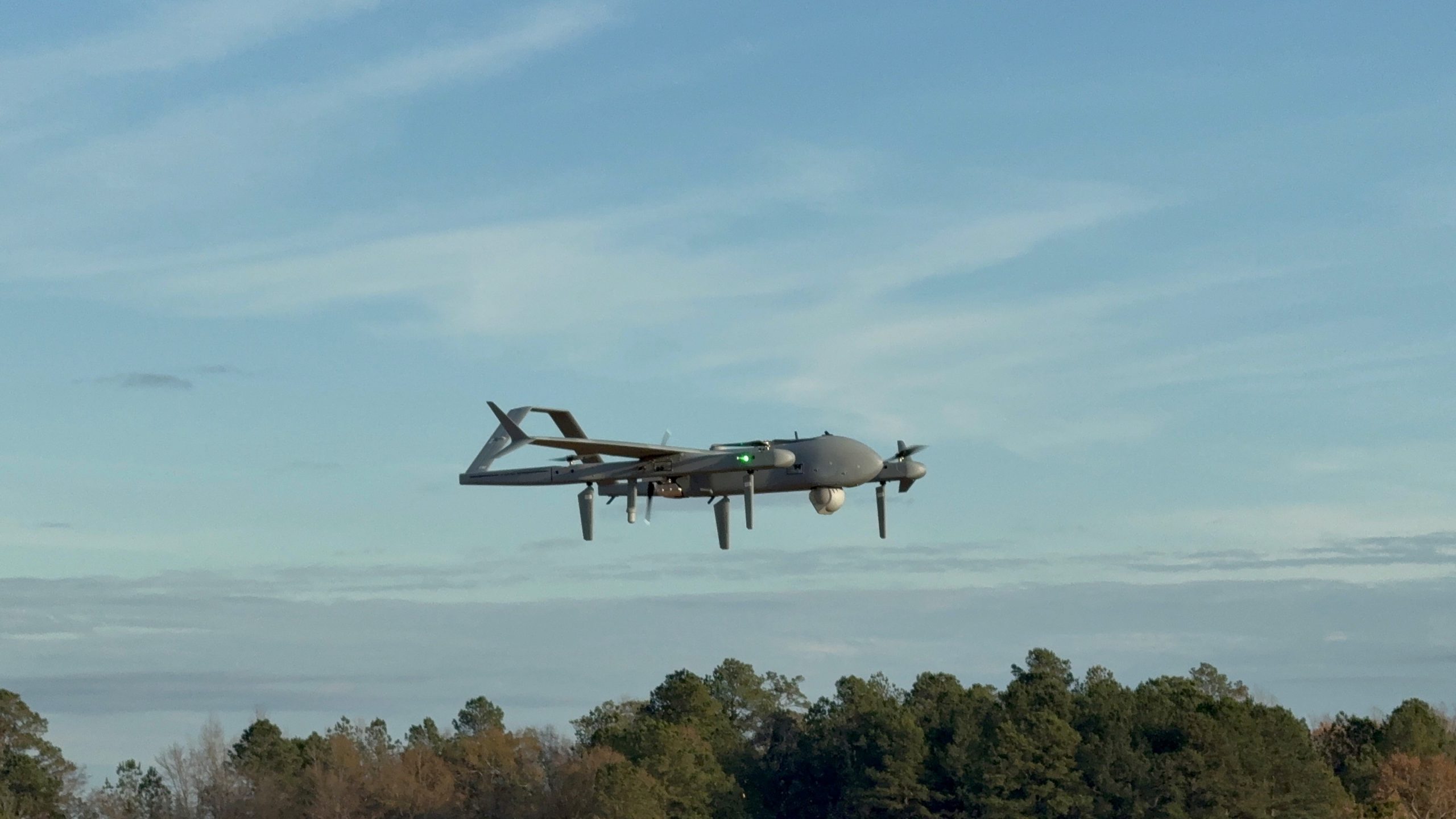
READY TO LAUNCH
The Uncrewed Aircraft Systems Project Management Office, in collaboration with the U.S. Special Operations Command, executed a successful flight demonstration involving the first launch of the Air-Launched, Tube-Integrated Unmanned System (Altius) 700 air vehicle on Dec. 3, 2023, at Fort Campbell, Kentucky. (Photo by Daniel Henke, U.S. Army)
Maintaining standards at the speed of relevance.
by Lt. Col. James Lawson, Maj. Lacey Losole and James Smith
Building or buying something quickly is easy; however, building or buying something quickly that will reliably and effectively perform for warfighters in life-or-death situations is a challenge worthy of the best and brightest minds in the DOD. In July 2024, the Army designated the Long-Range Precision Munition (LRPM) for development under a Middle Tier of Acquisition (MTA) pathway to rapidly prototype and evaluate a critical capability. LRPM is one of many Army efforts to swiftly address emerging threats and capability gaps, leveraging streamlined MTA authorities to accelerate timelines. However, to ensure LRPM is developed with responsible speed, the Army is taking a deliberate approach to tailor in the work necessary to balance rapid development with safety, suitability, effectivity and long-term supportability.
WHY MTA?
In the National Defense Authorization Act for Fiscal Year 2016 (Public Law 114-92, 425 Section 804), Congress granted DOD transformative new authorities for the “Rapid Prototyping and Rapid Fielding” of warfighting equipment under a new MTA framework. These authorities provide a radically streamlined alternative from the traditional Major Capability Acquisition (MCA) framework, with the spirit and intent of enabling accelerated development and delivery of critical capability to the warfighter.
The Army is continuously refining its MTA guiding policies, based on gained experience, to better align with its goal of fostering an innovative and streamlined acquisition framework. These policies encourage closer and quicker collaboration across the enterprise of stakeholder communities, minimizing bureaucratic barriers through two variants:
- MTA for “Rapid Prototyping” is designed to quickly prototype and evaluate emergent technologies for warfighting needs.
- MTA for “Rapid Fielding” is designed to quickly deliver transformative but mature technologies to Soldiers in the field.
MTA authorities significantly reduce the reporting requirements inherent in traditional MCA frameworks, empowering materiel developers to focus on responsive development, user feedback and technological refinement. By reducing documentation and oversight burdens, the MTA allows program offices to operate with greater agility and responsiveness. However, this reduction in mandated reporting does not absolve materiel developers of the need to deliver capabilities with responsible speed and responsible risk—thinking through enduring needs as well.
ENTER RESPONSIBLE SPEED
Responsible speed necessitates a balanced approach to acquisition, combining the agility of streamlined processes with deliberate and thorough decision-making. While MTA reduces the documentation and milestone requirements of MCA, materiel developers must still ensure deliberate cross-functional and expert reviews. These reviews address the core attributes of a capability including safety, suitability, effectivity and supportability to facilitate potential transition into a long-term acquisition framework. Responsible speed emphasizes that rapid development must not come at the expense of strategic foresight or comprehensive capability evaluations. Materiel developers, as vanguards of Soldier overmatch, must focus on accountability, agile development and creating a foundation for transition.
In three categories, responsible speed may be loosely characterized as:
- Accountability — Balancing the need for speed with the obligation to deliver safe, suitable, effective and supportable systems that meet operational demands. Meaning, program managers are responsible for assessing and accepting prudent risk to prototype and field a safe, suitable, effective and supportable capability in the most expeditious manner.
- Agile Development — Rapidly incorporating feedback from users and requirements from stakeholders to refine solutions. MTA programs must be structured and aligned to the thinking and execution approaches required to build to an initial set of requirements and then be receptive to feedback aimed to aid in development.
- Foundations for Transition — Posturing MTA programs to smoothly transition into enduring Programs of Record. Essentially, program managers and MTA stakeholders must be committed to not only moving fast but also thinking through the life cycle requirements, sustainment strategies and operational compatibility.
The fundamental challenge of an MTA is to execute with responsible speed and responsible risk, which means balancing delivering transformative capability, at the speed of relevance, while maintaining standards—despite the ability to tailor documentation. Enter one of the Army’s newest MTAs for Rapid Prototyping (MTA-RP), the LRPM.

MTA PAVING THE WAY
The MTA pathway enables quick prototyping and delivers transformative technologies to Soldiers in the field. (Graphic by USAASC)
THE LRPM VARIANT
The LRPM is the lethal, medium-range variant of the Army’s Launched Effects (LE) family of systems—a material solution to support multidomain operations at all echelons in a peer-threat environment. The LE uncrewed aircraft family of systems will deliver doctrinally transformative capability to the Soldier through a family of long-, medium- and short-range unmanned systems designed to be deployed from the ground and air.
The LRPM MTA-RP commenced with responsible speed in July 2024, following a series of acquisition shaping panels and a program initiation brief to the Hon. Douglas R. Bush, then assistant secretary of the Army for acquisition, logistics and technology (ASA(ALT)) and the Army Acquisition Executive (AAE). Bush designated LRPM as an MTA-RP program and charged the Program Executive Office for Missiles and Space (PEO MS) with decision authority and developing, procuring and testing this new lethal munition concept.
The MTA pathway provides a unique opportunity to fast-track LRPM prototyping and integrating emerging technologies. The MTA-RP framework minimizes bureaucratic hurdles, enables agile decision-making and supports operational employment quickly. By rapidly prototyping and demonstrating the capability in an operational environment, the Army can make an informed decision on the suitability of the materiel solution. A prescribed five-year MTA authority ensures accelerated timelines to assess solutions to immediate capability gaps, while simultaneously providing insights for further refinement on subsequent variants and iterations.
EXECUTING RESPONSIBLE SPEED
In December 2024, the LRPM MTA-RP Decision Authority, Maj. Gen. Frank J. Lozano, PEO MS, established the baseline LRPM hardware configuration comprised of an Anduril Altius A700M air-vehicle and multiple science and technology (S&T) initiatives from the Army Combat Capabilities Development Command’s (DEVCOM) Aviation and Missile Center (AvMC). The DEVCOM AvMC S&T initiatives included in the LRPM are the Multiple Simultaneous Engagement Technologies and Precision Target Acquisition Seeker software capabilities, a seeker and guidance section collectively developed by Hood Technology Corporation and DEVCOM AvMC and a DEVCOM AvMC-developed combined effects warhead. This configuration of the LRPM will undergo safety and suitability testing and be employed in follow-on ground and air-based operational demonstrations to inform production and deployment decisions.
In keeping with the themes of “responsible speed” and accountability, agile development and foundations for transition, there are various examples of functional application in the LRPM MTA-R.
ADAPTING TO RESPONSIVE REQUIREMENTS
An Abbreviated Capability Development Document (A-CDD) is a streamlined version of the traditional Capabilities Development Document that outlines essential performance requirements, operational needs and intended use of a system or capability in a concise manner. This abbreviated structure allows flexibility among the requirements, user and materiel developer communities to achieve a desired capability quickly, while informing the requirements community of what is possible. The A-CDD supporting the LRPM program is in evolution as lessons learned from ongoing conflicts improve understanding of what is necessary to develop a combat-effective system on a modern battlefield.
There is a natural conflict between an evolving A-CDD responding to battlefield realities and the stringent requirements necessary to place explosive munitions in the hands of Soldiers. Qualifying and testing a munition requires extensive and often sequential tests to ensure safety and reliability. In addition to ensuring safety validation requirements, LRPM is responsible for integrating emerging technologies to address the demands of the evolving battlespace. However, adoption of these technologies introduces risks to cost, schedule and performance. A critical aspect of this process is determining when to execute a branch plan to mitigate risk associated with long-lead requirements and ensure timely delivery of the LRPM to operational units.
“GOOD IDEA CUT-OFF” POINTS
The LRPM program must have a plan to integrate (or defer to a future LRPM version) the capabilities being developed for the LE enterprise (e.g., a multi-use air and ground launcher solution and a universal command and control system). Lozano directed the program to identify “good idea cut-off” (GICO) points. Essentially, to meet the constraints of the MTA timeline, the LRPM program must have off-ramps and alternatives if any of the LE-enabling capabilities are not mature enough to support the LRPM timeline. The LRPM program backward planned from mandated operational demonstration dates to identify the “no later than” points, which the LRPM must have access to properly incorporate and test.
The resultant product is a programmatic plan that incorporates GICO decision points with alternate paths to successfully execute. The program maintains active stakeholder engagement to understand the planned inclusion of emerging technologies and LRPM’s plan to incorporate the technologies in a future version. Active, transparent communication with stakeholders on current program status falls in the box of “must do” to achieve and maintain responsible speed.

RAPID PROTOTYPING IN ACTION
The U.S. Army’s Future Tactical Uncrewed Aircraft Systems (FTUAS) Product Office has officially taken receipt of the Textron Systems’ MK 4.8 HQ Aerosonde system, in December 2024, marking a significant milestone in the program’s Rapid Prototyping effort. (Photo by David Hylton, Program Executive Office for Aviation)
TESTING INCLUSIVITY
Developing a lethal munition inherently requires extensive safety and suitability testing requirements. The Department of Defense Instruction (DODI) 5000.80 (Operation of the Middle Tier of Acquisition), DODI 5000.89 (Test and Evaluation) and ASA(ALT) MTA Policy collectively indicate that an MTA-RP is bound, by regulatory and statutory responsibility, to develop a Test and Evaluation Strategy (TES, regulatory) and demonstrate and evaluate operational performance (statutory). The LRPM program has been deliberately inclusive with stakeholders during the development of the LRPM TES. Given the depth and breadth of munitions testing requirements and complexity of the program, there is no way to execute “responsible speed” without deliberate inclusivity. Borrowing the words of the Honorable Heidi Shyu (curated from her tenure as a former ASA(ALT) and AAE), “Everyone is on the acquisition accountability bus,” and there is no way to successfully arrive at the desired destination without coordinated participation.
CONCLUSION
The introduction of the MTA authorities significantly reduced the required documentation and reporting compared to traditional MCA. However, both acquisition paths can produce programs of record with established and statutory and regulatory information requirements. The DOD and the Army continue to evolve the guiding MTA regulations and policies based on lessons learned from early MTA programs that have completed transition. The LRPM program is leveraging the MTA authorities and executing with “responsible speed,” while also posturing to transition to a program of record if the Army deems the LRPM worthy of enduring operational use. The PEO MS, LE community, DOD and Army-enterprise stakeholder communities are dedicated to delivering transformative capability, at the speed of relevance, while meeting standards in system safety, suitability, effectivity and supportability.
For more information on LRPM, go to https://www.army.mil/peoms or contact the PEO MS Public Affairs at usarmy.redstone.peo-ms.list.msls-hq-public-affairs@army.mil.
LT. COL. JAMES LAWSON is the product manager for the Aviation Rockets and Small Guided Munitions Product Office in the Tactical Aviation and Ground Munitions Project Office and PEO MS at Redstone Arsenal, Alabama. He holds an MBA with an operations and supply chain management focus from the College of William and Mary and a B.S. in geospatial information science from the United States Military Academy. He is DAWIA Certified Advanced in project management.
MAJ. LACEY LOSOLE is an assistant product manager in the Aviation Rockets and Small Guided Munitions Product Office, supporting LRPM. She holds an MPA in public administration from the University of Hawaii, Manoa, and a B.S. in aviation management from Florida Institute of Technology.
JAMES (JIM) SMITH is a participant in the U.S. Army Acquisition Support Center Leadership Excellence in Acquisition Development (LEAD) program, Year Group 24, serving in a developmental detail to the Aviation Rockets and Small Guided Munitions Product Office, supporting LRPM. He has an M.S. in business administration from Central Michigan University and a B.A. in business administration from the University of Florida. He is a DAWIA Certified Practitioner in project management.







